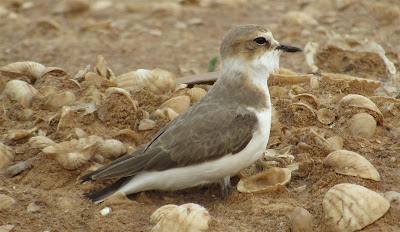West Nouakchott pools held many waders as usual. However the best was probably the two spotted redshank.
spotted redshank
DNA studies show it is closer to common greenshank than to common redshank despite its looks.
common greenshank with spotted redshank
Both these species were also present. Indeed there were high numbers of common greenshank.
wood sandpiper
Other waders included the unibiquitous wood sandpiper and little stint. Both are extremely common in water bodies in Nouakchott for at least half the year.
ruff
West Nouakchott pools gives me my best chance of anywhere in the city to see ruff.
spur-winged lapwing
red-billed quelea
In one of the bushes next to the pools, I found my first red-billed quelea in the city. I had speculated that this would happen as they are so numerous 30 kilometres south at the new water works. I believe the works is helping to act as a bridge for this species from its normal range near the Senegal River.
As far as I can tell, there has been at least one previous record of the species in the city and one further north near Atar.
kentish plover
On the scrubland close to the fishing port, I came across a Kentish plover which was starting to fake injury. This is a deflection tactic to move threats way from its young.
I gave it a wide bearth as soon as I saw it. There is no point stressing such a bird just to watch a display.
A short distance further but still short of the coast is a place gulls often settle in windy weather. There were plenty on Saturday.
Most of the gulls were lesser black-backed gull.
lesser black-backed gull with a ring
Two of them were young birds with the same pair of rings. I could only read one bird's rings. However I now know that this bird is from just north west of Edinburgh in Scotland. I see a large number of gulls with rings and ocassionally waders too.
When I finally arrived at the lagoons, south of the fishing port, it was apparent that the number and variety of terns was the highest since last September.
little tern
Five little tern were grouped together.
Caspian tern and a common tern
Both common tern and arctic tern pass Nouakchott on migration in large numbers though neither often land here. Indeed this is only the second common tern I have seen on land since I arrived. The previous one was in poor condition in autmn near Nouadhibou.
Arctic tern are less likely still to land. They usually migrate well out to sea. However Saturday's westerly wind was unusual.
This bird is definitely a common tern. It's bill has a dark tip and its wings aren't long enough.
mixed species with a common tern
In the far end of the lagoons near the supply pipe, a single white-winged black tern was in the same area as a few waders including a red knot as well as several swimming slender-billed gull.
white-winged black tern
The final tern in the area was sandwich tern. Many were feeding over the water and close into shore.
sandwich tern
Gull numbers are definitely thinning out now, none more so than black-headed gull.
black-headed gull
Most slender-billed gull that remain are immatures. Surely they will over-summer as do many of their countereparts in the Gulf. At least one adult still remained though.
slender-billed gull
Apart from the red knot already mentioned, waders this time were a little disappointing.
sanderling with a little stint
Four great white pelican flying over the water were the only other birds of consequence.
I will keep visiting the fishing port over the next few weeks. Overall, things are moving pretty fast now.

















No comments:
Post a Comment